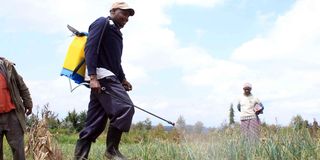Crop protection in onion production

A farmer sprays his onion crop with a herbicide in Endarasha, Nyeri County. A farmer needs to use chemicals approved by the Pest Control Products Board.
Desmond is still carrying out routine management practices on his crop.
In this article, we look at the use of crop protection products in onion production.
The products play an important role in controlling pests and diseases.
However, they carry risks if not properly used. They can have adverse effects on workers, their families, livestock and the environment.
It is important to communicate relevant procedures on personal health, safety and hygiene to staff in order to minimise risks.
The products play a critical role after prevention measures have been executed and alternatives for pest control exhausted.
This means the initial level of pests and diseases could not be reduced to a sufficient level, requiring chemical interventions.
It ensures the production of healthy and safe food. I took farmer Desmond through the measures he should take into account while using crop protection products.
First, he should consider chemicals that have been approved for onion production by the Pest Control Products Board (PCPB).
While buying the products, Desmond should always check for the PCPB registration number and the chemical should be in its original container.
The chemicals should be appropriately used, considering the recommended rate of application as per the maker’s instructions.
For instance, if required to use 5ml in 20 litres of water, the farmer should use the rate as an under or overdose reduces the efficiency of the chemical.
In that case, the pest or disease can easily develop resistance to the chemical.
Overdose also results in high chemical residues that are harmful to the environment, animals and people.
The knapsack sprayers should be well calibrated to enhance their efficiency.
The objective of spray application is to get the products to the target pest, not drown it.
It is not necessary to use large quantities of water to evenly cover the crops and field, as “washing” the plants results in large amounts of the products running off to the ground.
This contributes to wastage, environmental contamination and increases the production cost.
Use the right chemical to control the correct pests and diseases.
The farmer should observe the pre-harvest interval, which refers to the period that must elapse after spraying the chemical and before harvesting.
The pre-harvest and re-entry intervals are indicated on the label of every chemical.
Re-entry interval, which refers to the period that must elapse after spraying and before workers are allowed on the farm, should also be observed.
It is important for a farmer to ensure there is a crop protection unit where the mixing of the chemicals can take place.
The farmer should have a soak pit for spills and residue and a pit for disposing of the waste.
The two should be away from the grading area.
When the onions are almost ready for harvest, do not use herbicides to dry the leaves as this results in high chemical residue.
It is important for Desmond to ensure the chemicals used are registered by the PCPB.
Next week, we shall look at the farm work plan that Desmond has been using.





